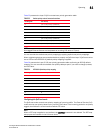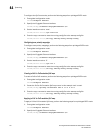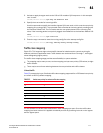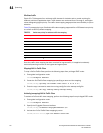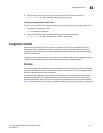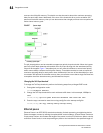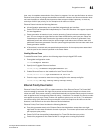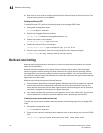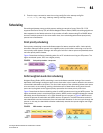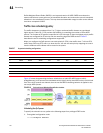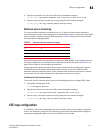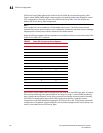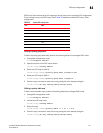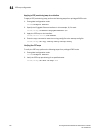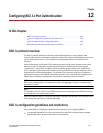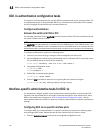
Converged Enhanced Ethernet Administrator’s Guide 117
53-1002163-02
Scheduling
11
DRAFT: BROCADE CONFIDENTIAL
3. Enter the copy command to save the running-config file to the startup-config file.
switch(config)#do copy running-config startup-config
Scheduling
Scheduling arbitrates among multiple queues waiting to transmit a frame. Fabric OS v7.0.0
supports both Strict Priority (SP) and Deficit Weighted Round Robin (DWRR) scheduling algorithms.
Also supported is the flexible selection of the number of traffic classes using SP-to-DWRR. When
there are multiple queues for the same traffic class, then scheduling takes these equal priority
queues into consideration.
Strict priority scheduling
Strict priority scheduling is used to facilitate support for latency-sensitive traffic. A strict priority
scheduler drains all frames queued in the highest priority queue before continuing on to service
lower priority traffic classes. A danger with this type of service is that a queue can potentially starve
out lower priority traffic classes.
Figure 8 describes the frame scheduling order for an SP scheduler servicing two SP queues. The
higher numbered queue, SP2, has a higher priority.
FIGURE 8 Strict priority schedule — two queues
Deficit weighted round robin scheduling
Weighted Round Robin (WRR) scheduling is used to facilitate controlled sharing of the network
bandwidth. WRR assigns a weight to each queue; that value is then used to determine the amount
of bandwidth allocated to the queue. The round robin aspect of the scheduling allows each queue
to be serviced in a set ordering, sending a limited amount of data before moving onto the next
queue and cycling back to the highest priority queue after the lowest priority is serviced.
Figure 9 describes the frame scheduling order for a WRR scheduler servicing two WRR queues. The
higher numbered queue is considered higher priority (WRR2) and the weights indicate the network
bandwidth should be allocated in a 2:1 ratio between the two queues. In Figure 9 WRR2 should
receive 66 percent of bandwidth and WRR1 receives 33 percent. The WRR scheduler tracks the
extra bandwidth used and subtracts it from the bandwidth allocation for the next cycle through the
queues. In this way, the bandwidth utilization statistically matches the queue weights over longer
time periods.
FIGURE 9 WRR schedule — two queues



